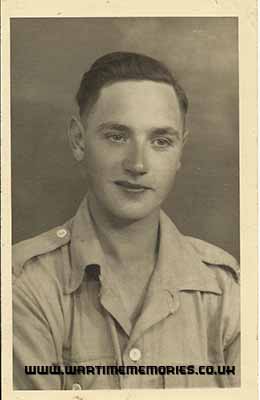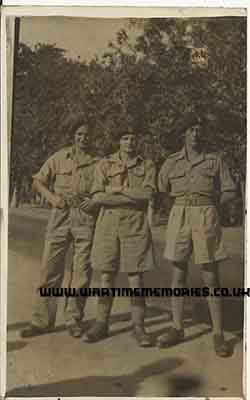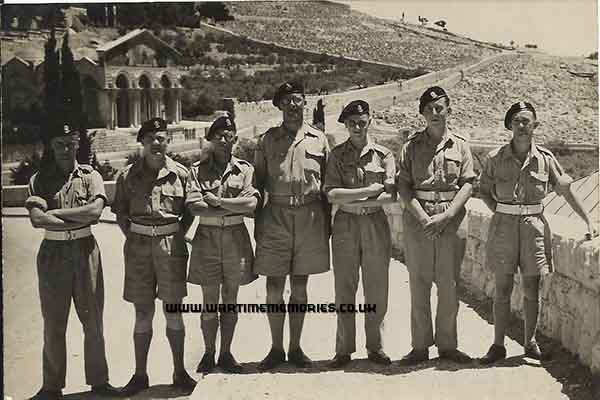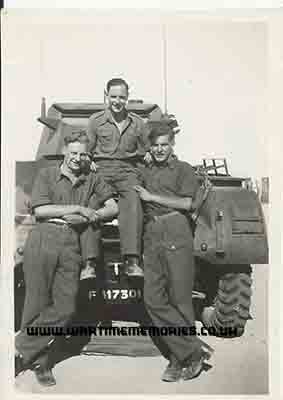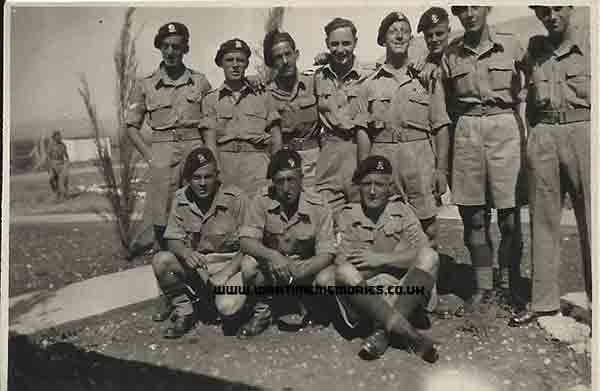Tpr.r Garfield Desmond "Gary" Hedges
British Army Royal Armoured Corps Reconnaissance Corps Â
from:53 Metford Road, Clifton, Bristol.
Garfield Desmond Hedges was known as Gary, he attested at a Territorial Army Centre in Bristol on the 11th of January 1944 to The Reconnaissance Corps. Army No: 14443768. He served with the R.A.C. 11-01-44 to 07-08-45, Yorkshire Hussars 08-03-45 to 24-09-45, 15/19 Kings Royal Hussars 25-09-45 to 24-12-47 and his Demobilisation was on 01-10-47 from Aldershot Barracks.
It is unknown where Gary Hedges did his basic training, but he ended up at Catterick Barracks in Yorkshire for driver training and then became a trainer himself, for the Universal (Bren-Gun) Carrier. Possibly made a Lance Corporal, but we think due to what was then called word blindness (Dyslexia) Gary refused further advancement as he was offered a commission. We believe Gary was still in his initial training during D-Day 6th June 1944. Gary lost many friends in Operation Market Garden in Ahnem as he was continuing to train troops on Universal Carriers (Bren-Gun Carrier). We think Gary Hedges joined his Regiment in January 1945 in Germany and was with the advance units and liberated Bergen-Belsen Concentration camp on 15th April 1945.
Gary told us a story later in his life that, when he was there all the troops gave their rations to the prisoners, but found that because the prisoners were so weak, they died from the rich food, so they then tried giving blood transfusions and again, most of the troops present gave their blood. A little while later, the Army Medical personnel used a special famine food with added glucose and the ex-prisoners began to improve. There was also typhus epidemic present and the prisoners were eventually de-loused using D.D.T. as an effective pesticide. Those prisoners who were too weak to move by themselves were put on benches and washed by S.S. nurses, before being moved away from the infected area. (Most of the S.S. nurses contracted typhus and died.) After all of the prisoners had been de-loused and washed and stabilised, they were moved to the Displaced Persons Camp (D.P. Camp) which was housed in a former tank (Panzer) barracks. This housed 11,000. people, most of whom emigrated to Palestine. Gary Hedges and his fellow troops were also involved with the Displaced Persons in Northern Germany and ordered to de-louse many people using D.D.T. pesticide.
After VE Day (Victory in Europe) the Reconnaissance Regiment was disbanded. Gary Hedges was then transferred to the 15/19 King’s Royal Hussars and sent to Palestine in 1945. He was present when the King David’s Hotel was bombed by the Jewish group the Irgun, 13 soldiers were killed on the 22 July 1946. Which was used as the administrative centre for Palestine. 91 people were killed in total and 1 Irgun member was shot and later died. The Irgun were a militant right wing Zionist underground organisation who acted under the political direction of the Jewish Resistance Movement and under the Jewish Agency who were against the Palestine mandate. The British rule over Palestine followed the end of WW1 and removal of the Ottoman Empire in the region. The British were there to keep the peace between the Arabs, Christians and the Jewish Nations. He continued in a policing role and was possibly present during the terrorist outrage, when 2 British soldiers (Sgt Paice & Sgt Martin in July 1947) were kidnapped by the Irgun and later hanged in a polishing factory and the bodies then hung in a Eucalyptus Grove and an I.E.D. placed in the ground under the bodies which later activated when the bodies were cut down, causing facial injuries to one British Officer. Gary Hedges continued to serve until 1947 when he said he returned to Britain and shovelled snow, (1947 was a bad winter for snow) before being demobbed.
3rd Reconnaissance Regiment was formed from 8th Battalion Royal Northumberland Fusiliers, who landed in France on 6th June 1944 and served in North West Europe 1944-45. On 11/01/1944 the 26 regiments of The Reconnaissance Corps were transferred to The Royal Armoured Corp, (RAC) retaining their own cap badges and it was not until spring 1945 that all units had finally discarded the Recce Corp’s khaki beret for the RAC’s black beret which should have adopted upon joining the RAC.
The Recce Corps had been formed in January 1941, officially on the 14th, but some units (initially termed battalions, but later regiments, a term some of the battalions had been calling themselves anyway following the cavalry tradition) dated their formation from January (1st and 8th). Originally conceived as The Infantry Reconnaissance Corps, it had been raised to fill the gap for armoured reconnaissance in infantry divisions, there being insufficient cavalry to do so. Generally, the battalions / regiments of The Recce Corps served with the infantry divisions which bore the same number e.g. 1st Reconnaissance Regiment served with 1st Infantry Division, 3rd Reconnaissance Regiment with 3rd Infantry Division, 46th Reconnaissance Regiment with 46th Infantry Division.
The 11th Armoured Division, known as The Black Bull, was a British Army division formed in 1941 during the Second World War. The Division was formed in response to the unanticipated success of German panzer divisions. It was responsible for several major victories in Normandy after D-Day, and it participated in the rapid advance across France, Belgium, and the Netherlands and the Rhine crossing. The Division was disbanded in January 1946 and reformed towards the end of 1950.
The Component Units (On 6 June 1944) : British 29th Armoured Brigade, 3rd Royal Tank Regiment, 23rd Hussars, 2nd Fife and Forfar Yeomanry, 8th battalion The Rifle Brigade, British 159th Infantry Brigade, 4th battalion The King's Shropshire Light Infantry, 1st battalion The Herefordshire Regiment, 3rd battalion The Monmouthshire Regiment, Divisional troops, 2nd Northamptonshire Yeomanry, 13th (Honourable Artillery Company) Regiment, Royal Horse Artillery, 151st (Ayrshire Yeomanry) Field Regiment, Royal Artillery, 75th Anti-Tank Regt, Royal Artillery, 58th (Argyll and Sutherland Highlanders) Light Anti-Aircraft Regiment, Royal Artillery, 15th/19th The King's Royal Hussars.
Michael Bentine (Comedian & Writer) wrote this on his encounter with Belsen: We were headed for an airstrip outside Celle, a small town, just past Hanover. We had barely cranked to a halt and started to set up the ‘ops’ tent, when the Typhoons thundered into the circuit and broke formation for their approach. As they landed on the hastily repaired strip – a ‘Jock’ [Scottish] doctor raced up to us in his jeep. ‘Got any medical orderlies?’ he shouted above the roar of the aircraft engines. ‘Any K rations or vitaminised chocolate?’ ‘What’s up?’ I asked for I could see his face was grey with shock. ‘Concentration camp up the road,’ he said shakily, lighting a cigarette. ‘It’s dreadful – just dreadful.’ He threw the cigarette away untouched. ‘I’ve never seen anything so awful in my life. You just won’t believe it 'til you see it – for God’s sake come and help them!’ ‘What’s it called?’ I asked, reaching for the operations map to mark the concentration camp safely out of the danger area near the bomb line. ‘Belsen,’ he said, simply. Millions of words have been written about these horror camps, many of them by inmates of those unbelievable places. I’ve tried, without success, to describe it from my own point of view, but the words won’t come. To me Belsen was the ultimate blasphemy. After VE. Day I flew up to Denmark with Kelly, a West Indian pilot who was a close friend. As we climbed over Belsen, we saw the flame-throwing Bren carriers trundling through the camp – burning it to the ground. Our light Bf 108 rocked in the superheated air, as we sped above the curling smoke, and Kelly had the last words on it. ‘Thank Christ for that,’ he said, fervently.
On 11th of April 1945 Himmler agreed to have the camp handed over without a fight. SS guards ordered prisoners to bury some of the dead. The next day, Wehrmacht representatives approached the British and were brought to 8th Corps. At around 1 a.m. on April 13, an agreement was signed, designating an area of 48 square kilometres (19 square miles) around the camp as a neutral zone. Most of the SS were allowed to leave. Only a small number of SS men and women, including the camp commandant Kramer, remained to "uphold order inside the camp". The outside was guarded by Hungarian and regular German troops. Due to heavy fighting near Winsen and Walle the British were unable to reach Bergen-Belsen on April 14, as originally planned. The camp was liberated on the afternoon of April 15, 1945. Bergen-Belsen displaced persons camp was a displaced persons (DP) camp for refugees after World War II, in Lower Saxony in north-western Germany, southwest of the town of Bergen near Celle. It was established by British forces near the Bergen-Belsen concentration camp. The site used abandoned German army Panzer barracks for housing facilities, and after November 1945, Jewish refugees were given their own section. The camp was the largest DP camp in Germany with 11,000 residents in 1946 and the only exclusively Jewish facility in the British sector.
